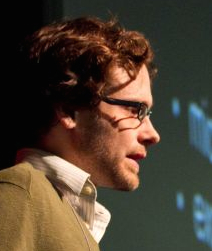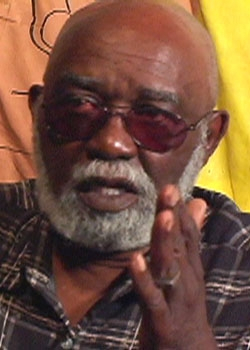The Leimert Phone Company
by Karl Baumann, Benjamin Stokes, François Bar, and Ben Caldwell
published July 2014
Project Description:
The Leimert Phone Company is a design collaborative that seeks to reimagine the phonebooth. We are repurposing old payphones for civic engagement and storytelling on local streets. The project was born in Leimert Park, a neighborhood in South Los Angeles famous for its African American culture. Across the country, public phonebooths are dying. Is this a hidden opportunity to reclaim physical space and shift the narrative of the neighborhood? We go beyond booths as wifi hotspots. This project reveals an ambitious strategy for a “payphone redesign,” mixing installation art with mobile technology and activism. Members of the Leimert Phone Company include a diverse mix of artists and technologists from Leimert (anchored by KAOS Network) and the nearby University of Southern California (USC).
What does a payphone look like when deeply redesigned? We advocate for mixing low-tech with high art and real organizing. Can the design be participatory? We focus on intercommunity dialogue at every step of the process. The Leimert Phone Company shows how ordinary booths can be sites for participatory design and transmedia storytelling tied to justice.
The project was sparked by two complementary questions. (1) How can we better utilize an abandoned payphone outside of our partner’s building in Leimert Park? (2) With ongoing subway development and fears of gentrification, how can public arts and technology reinforce the cultural identity of that neighborhood and help plan for the future? From there, the project became an experiment in exploring how the payphone fit within the complex socio-technological ecology of the neighborhood. In order to build for this specific ecology, a collaboration was formed between technologists and media makers from USC alongside local artists, musicians, and residents of the Leimert Park area. Alternating between a university lab and our community center, multiple visions emerged to re-invent payphones and bring the digital into public space, linking local businesses to cultural preservation and city services. Bridges to mobile devices addressed basics like charging, but also emphasized deeper social recipes for combination—like a public speaker for rap sessions that remixes music from the phones of participants.
The future of the local community may depend on the residents’ ability to plan their own technology and not just create content. As mobile technologies permeate civic life and public space, the tension is increasingly important between top-down engineering and the structure of bottom-up participation. Public phones provide an established interface for communication, and just like smartphones, their future may not be about the audio call. Phonebooths can bridge the physical and digital worlds, deepening a hybrid sense of place. The physical footprint of payphones is distinct, though in most neighborhoods the payphones desperately need repair. Rather than assume obsolescence, we ask if their aging presence is a hidden opportunity. Can the hacking of payphones by residents, coupled with a broader reimagining, offer distinct critiques of the neighborhood itself, almost like urban planning? Our project is an attempt to catalyze a participatory culture that draws from urban planning, technology design, and socially engaged art in order to build an embedded design that accentuates the cultural assets and civic engagement of the neighborhood.
Postscript:
For an unfolding picture of Leimert Park, see the Los Angeles Times neighborhood profile page: http://maps.latimes.com/neighborhoods/neighborhood...
Also, see the Wikipedia entry on the neighborhood: http://en.wikipedia.org/wiki/Leimert_Park,_Los_Ang...
For more information on the Leimert Phone Company, see: http://LeimertPhoneCompany.net
Works Cited
Bar, François, Francis Pisani, Matthew Weber. “Mobile technology appropriation in a distant mirror: baroque infiltration, creolization and cannibalism.” Seminario sobre Desarrollo Económico, Desarrollo Social y Comunicaciones Móviles en América Latina. Buenos Aires: Abaporu Project, 2007. 1-41. my.ss.sysu.edu.cn. Web. 22 May 2014.
Bilandzic, Mark, and John Venable. “Towards Participatory Action Design Research: Adapting Action Research and Design Science Research Methods for Urban Informatics.” The Journal of Community Informatics 7.3 (2011): n. pag. Web. 14 Oct. 2013.
DiSalvo, Carl, Andrew Clement, and Volkmar Pipek. “Communities: Participatory Design for, with, and by communities.” Routledge International Handbook of Participatory Design. Eds. Jesper Simonsen and Toni Robertson. New York: Routledge, 2013. 182-209. Print.
Farman, Jason. The Mobile Story: Narrative Practices with Locative Technologies. New York: Routledge, 2013. Print.
Gurstein, Michael. What is Community informatics (and why does it matter)?. Milano, Italy: Polimetrica. 2007. Print.
Horelli, Liisa, ed. New Approaches to Urban Planning - Insights from Participatory Communities. Helsinki: Aalto University, 2013. aaltodoc.aalto.fi. Web. 1 Oct. 2013.
Pries-Heje, Jan, Richard Baskerville, and John Venable. “Soft Design Science Research: Extending the Boundaries of Evaluation in Design Science Research.” Proceedings from the 2nd International Conference on Design Science Research in IT (DESRIST) (2007): 18–38. Print.
Saad-Sulonen, Joanna. “Multiple Participations.” New Approaches to Urban Planning - Insights from Participatory Communities. Helsinki: Aalto University, 2013. 111-130. aaltodoc.aalto.fi. Web. 1 Oct. 2013.
Simonsen, Jesper, & Robertson, T. Routledge International Handbook of Participatory Design. New York:Routledge, 2012. Print.




